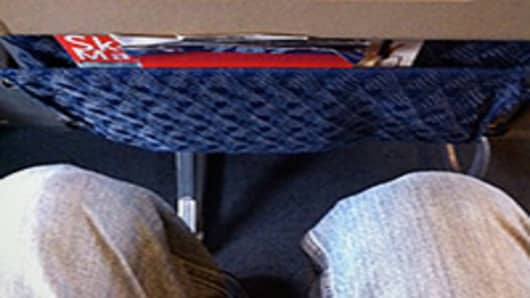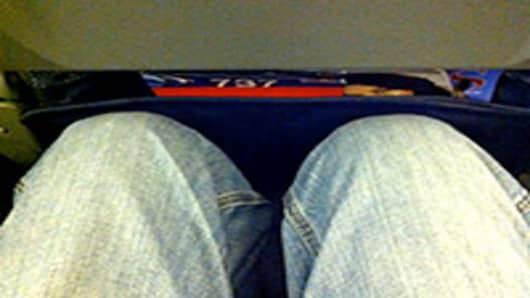With fuel prices on the rise again, airlines are looking for ways to increase revenue beyond fare increases and charging add-on fees. New tactics are coming at the expense of your knees.
Many airlines are adding seats and shrinking legroom in the economy section by reducing seat pitch — the amount space from one point on the seat to the same point on the row ahead — swapping out thicker seat cushions for thinner ones or installing new seat architecture.
For passengers over 6 feet tall, myself included, legroom is an important consideration when selecting a seat or airline. And legroom from one aircraft to another on the same airline can differ. That's my legroom pictured on an American Airlines Boeing 757 last year. Not bad, actually. But on my return flight a few days later on a different aircraft, it was much tighter.
Which airlines are making changes that are not-so-friendly to your knees? Read on.
Southwest Airlines:
In March, Southwest began retrofitting its fleet with a new Evolve interior. Each seat is 6 pounds lighter than previous models with thinner cushions. In a blog post on Southwest's website, the airline admits this allows them to increase the number of seats on board from 137 to 143 on some aircraft. It claims that seat comfort and space isn't sacrificed, but I've heard reports to the contrary, particularly from hard-core road warriorson Flyertalk.com.
JetBlue:
This month, JetBlue has added enhanced legroom seats, dubbed Even More Space, to its fleet of Embraer 190 aircraft. As Conde Nast Traveler contributor Brett Snyder points out, this has come at the expense of a tighter seat pitch for those seated further back in the coach cabin.
United Airlines:
When selecting new seats for the cabin overhaul of its Airbus fleet, United went with popular European manufacuter Recaro. Slated to begin next year, United's 152 narrow-body Airbus aircraft will be fitted with slimmer seats. The airline also claims seat comfort won't be sacrificed, but the refit will enable an extra row of seats to be added to each aircraft. I'm not convinced.
American Airlines:
Compare the seat pitch photo up top to the one appearing at left. Here I'm on board one of American's new Boeing 737-800 aircraft that has two additional rows of seats over its other 737-800 configuration. Seat pitch has been reduced, but to mitigate the 1-inch less of space, the seats do not recline. Instead, the seat bottom slides forward while the back slouches within a shell. While my knees aren't crushed by the seat in front reclining, I found it far less comfortable than the 757.
What does this all mean? In my experience, having top-tier elite status has been a saving grace. Because of my frequent travels on United and American, I have complimentary access to the best seats in the house on those airlines when flying in coach.
When flying other airlines where I don't have status, it's making those add-on fees for better seats more attractive by the day.
What do you think? Is the legroom crunch impacting your choice of airline or making you buy-up to seat offering more legroom?




